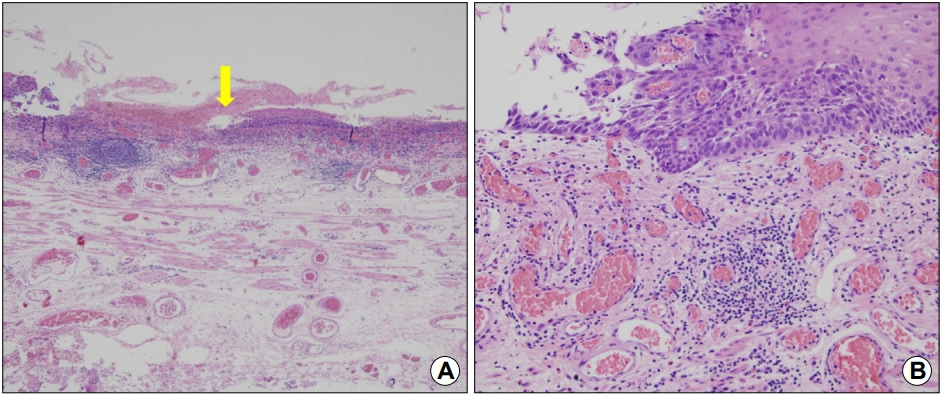Question: A 74-year-old man visited for the evaluation of indigestion for indigestion. Upper gastrointestinal endoscopy revealed a reddish longitudinal mucosal break at the lower esophagus; grade B reflux esophagitis (Los Angeles classification) was diagnosed (Fig. 1A). He was administered a proton pump inhibitor (PPI) once a day for 2 months. On follow-up endoscopies 2 and 3 years later, the mucosal break was still present (Fig. 1B, C), and then he took a PPI repeatedly. On follow-up endoscopy 4 years later, there was no change in the mucosal break (Fig. 1D).
What is the most likely diagnosis?
Answer: Endoscopic forceps biopsy was performed for the persistent mucosal break. Biopsy of this lesion disclosed a well-differentiated squamous cell carcinoma. EUS revealed tumor invasion of only the mucosa, and chest and abdominal CT scanning found no metastases. Therefore, he underwent endoscopic submucosal dissection that removed the lesion completely (Fig. 2). On histopathologic examination, the cancer cells were located at the falling off epithelial layer (Fig. 3A), and invasion of the cancer from the basal layer into the lamina propria mucosae was noted (Fig. 3B). This patient has been followed-up for 4 years since endoscopic submucosal dissection, with no evidence of recurrence.
Reflux esophagitis can progress to adenocarcinoma, as like many other chronic inflammatory conditions [1]. Inflammation in the mucosal break also can result in regenerative atypia that is sometimes confused with dysplasia, but that does not have malignancy as its end result [1]. Therefore, it is recommended to perform endoscopic biopsy when the inflammatory reaction has subsided after PPI administration. However, in the present case, the mucosal break was single, and its shape was not changed during follow-up. At this situation, endoscopic biopsy for the unchanged mucosal break is needed not to miss carcinoma mimicking inflammation [2]. We always remember that we should not make definite assumptions about histology from the gross appearance of a lesion.












